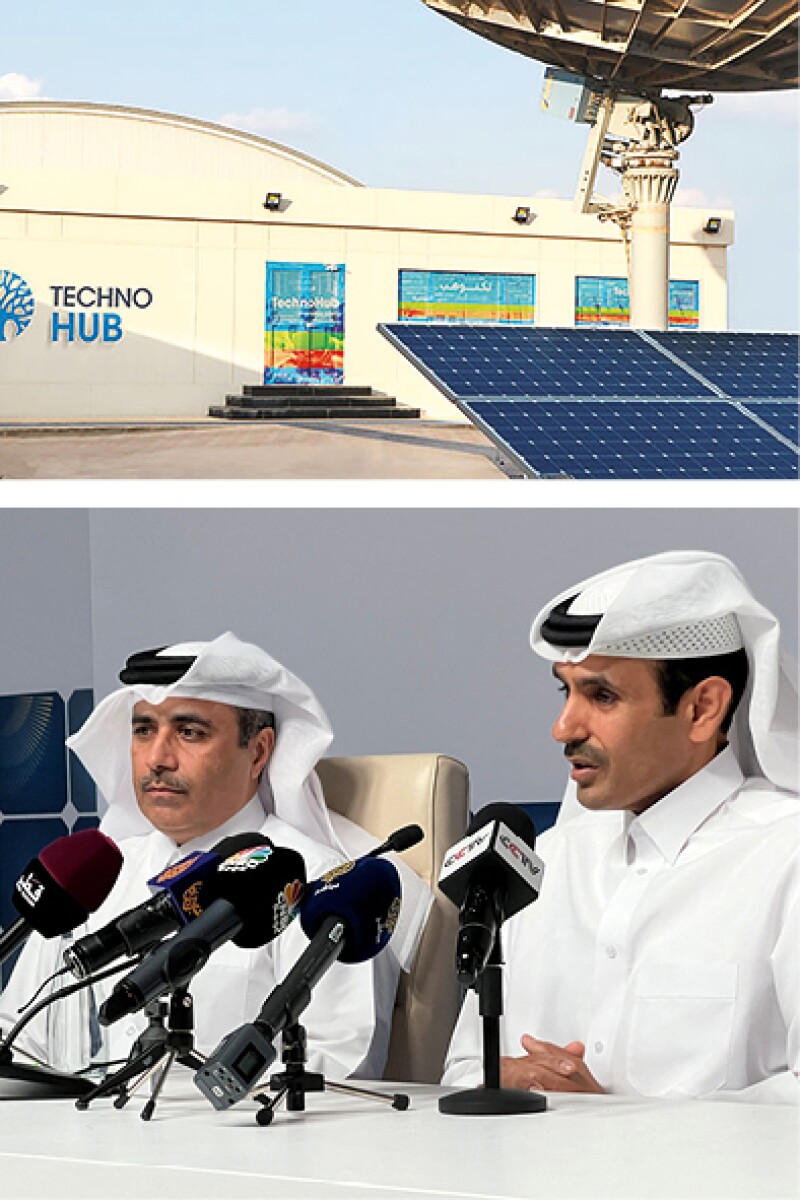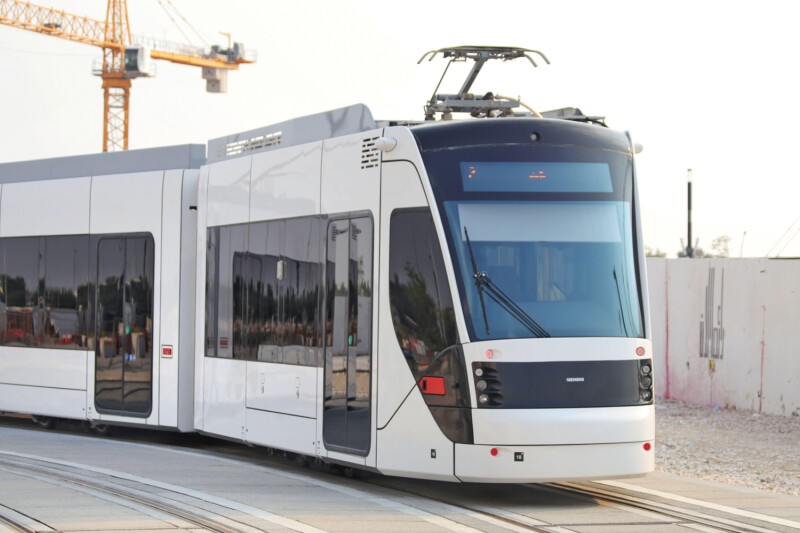Qatar famously has the world’s third largest gas reserves, which have provided plentiful, cheap electricity and served as a major driver of economic growth.
The hydrocarbon sector contributed an average 38% of real GDP between 2019 and 2021, according to S&P Global Ratings. This fell only slightly in 2022, when hosting the football World Cup increased the contribution from other sectors.
Looking to the future, the country’s abundant gas fields will continue to help finance Qatar’s transformation and provide an important source of activity for domestic banks.
The flagship North Field Expansion (NFE) project — one of the largest industrial projects in the world — will bring six new gas liquefaction trains, boosting production by over 60%. This will help maintain Qatar’s dominance in the liquefied natural gas market, ensuring the country is protected from inflationary pressures being felt elsewhere in the region.
There will be attendant benefits for industries that rely on LNG, including Qatar’s world-beating petrochemical and fertiliser firms. For the banks, there will be ample opportunity to help finance sub-contractors and downstream operators.
Natural gas is also an important base fuel that can help drive the global energy transition and there is much Qatar can do to reduce LNG emissions. Sheikh Fahad Bin Mohammad Bin Jabor Al Thani, chairman of Doha Bank, notes that Qatar’s Vision 2030 aims to have the country assume a leading international role in assessing the impact of climate change and how to improve mitigation.
Although Qatar will continue to develop its natural gas sources, Vision 2030 also highlights the importance of energy efficiency. The country’s energy sustainability strategy includes a variety of targets to improve performance across the LNG sector and boost renewable energy capacity. In total, Qatar aims to reduce the carbon intensity of its LNG operations by around 30%.
Capturing value and emissions
The authorities are already hard at work making this vision a reality. Earlier this year, French firm Technip Energies was awarded the engineering, procurement, and construction contract for the North Field South project. This will include two new LNG mega-trains with a combined capacity of 16 million tonnes per annum, but the project also includes a large CO2 carbon capture and sequestration (CCS) facility. Technip estimates that the CCS system will capture 1.5 million tonnes of carbon each year — reducing emissions by 25%. The firm has a similar contract for the North Field East project.
Recognising the huge potential for combining LNG production with CCS, Qatar’s government is working hard to support and develop carbon capture technology. The first ever MENA region Capture Capital Utilisation and Storage (CCUS) forum took place in Qatar in May this year, and the authorities are investing heavily to meet a target of capturing 11 million tonnes of CO2 each year by 2035.
Key technology incubators include the Gulf Organisation for Research & Development (GORD) Institute based in the Qatar Science and Technology Park. Focussed on using scientific research to improve sustainability, the institute’s research projects include reducing CO2 emissions in the built environment and — in collaboration with University College London — CCUS systems for gas-fired combined heat and power schemes. Visitors to the science park during the carbon capture forum were treated to demonstrations of the latest innovations from global leaders including Shell, ExxonMobil and General Electric.
“CCS is being used to reduce emissions from the country’s operations in the already cleaner-burning natural gas sector, while green building initiatives promote sustainable building practices and environmentally friendly construction,” says Ahmed I. Hashem, acting group CEO of Dukhan Bank. “All of these areas offer excellent prospects to potential investors.”
Qatar has multiple attributes that make it suitable for carbon capture. The country’s geology and underground gas deposits are ideal for storing CO2. Its large scale, concentrated LNG infrastructure, meanwhile, is optimal for CCUS hubs.
Major industrial centres like Ras Laffan have large manufacturing operations that could also benefit from carbon capture. QatarEnergy has signed a memorandum of understanding with GE to develop a carbon capture roadmap for the country’s energy sector. This includes exploring the development of a “world scale” carbon hub at Ras Laffan.
Sun and wind
The ambition and intent do not end there. As part of Qatar’s commitments to the Paris Agreement and its own Vision 2030 goals, the authorities have set a target to bring renewables up to 20% of its total electricity generation capacity by 2030.
“Qatar has made significant progress in recent years in advancing renewable energy and energy efficiency initiatives,” says Joseph Abraham, group CEO of Commercial Bank of Qatar. “This strategic commitment aligns with the nation’s goals to diversify its energy sources, reduce its carbon footprint and contribute to global sustainability efforts.”
The government itself has set an example, by widely installing solar panels on ministry buildings and establishing the Qatar Environment and Energy Research Institute to explore renewable energy and environmental responsibility.
One important entity dedicated to building out renewables is Siraj Energy, formed through a joint venture between QatarEnergy and Qatar Electricity & Water (QEWC). Last year, QatarEnergy agreed to buy the remaining 49% stake in Siraj from QEWC as part of its 4C Climate Framework, which will significantly reduce the carbon intensity of its upstream operations and LNG facilities by 2030.

Given its location, Qatar’s solar potential is enormous and this is reflected in the scale of the projects. Late last year, the country inaugurated its first large solar power installation — the 1,000 hectare Al Kharsaah plant, developed by a consortium that includes Siraj and TotalEnergies.
Two million solar modules spread over an area the size of 1,400 football fields have the potential to generate 800MW — enough to cover 10% of the country’s peak demand. TotalEnergies estimates that over the plant’s lifetime it will reduce the country’s CO2 emissions by 26 million tonnes.
Several other major projects are already under way. QatarEnergy Renewables Solutions has picked Samsung C&T as the contractor for its industrial cities solar power project IC Solar.
This will see two more large scale solar photovoltaic plants built at the Mesaieed Ras Laffan Industrial cities. The authorities hope these will come online in late 2024, taking the country’s total renewable generation capacity up to 1.675GW.
That will have to increase much more if the country is to meet its goal of 5GW of solar power by 2035, but BMI analysts expect solar generation capacity to increase rapidly, at an average of over 16% each year between 2022 and 2032.
Qatar’s wind power potential may not match that of its solar endowment. But the authorities have recognised a resource of major value. The Asia Wind Energy Association highlights the particular promise for projects along the Qatar-Bahrain Causeway. “Although wind energy has less potential than solar in Qatar, technological advances and falling costs have led to the development of offshore wind energy projects,” says Ahmed I. Hashem at Dukhan Bank.
Selected aspects of QatarEnergy’s Sustainability Strategy
- Methane intensity reduction to 0.2% by 2025
- Carbon intensity reduction of 15%-25% from upstream and 25%-35% from LNG facilities by 2030
- Zero routine flaring by 2030
- Addition of 2GW to 4GW of renewable energy by 2030
- Deployment of carbon capture and sequestration technology to capture over 11 million tonnes per annum of CO2 by 2035
Source: International Energy Agency
Holistic approach
Sustainability is about far more than simply building renewable energy capacity, and Qatar’s efforts are placing the country at the cutting edge of sustainability on multiple fronts.
It boasts the Middle East’s largest waste management facility — the Domestic Solid Waste Management Centre in Mesaieed — which generates 50MW of electricity and helps produce organic fertilisers.
Ooredoo Qatar has partnered with Ericsson to install the firm’s Smart Connected Site Solution across its telecom operations. This allows Ooredoo sites to use lithium ion batteries, dramatically reducing reliance on diesel generators and the grid.
Qatar’s desert environment brings sunlight for solar, but also challenges when it comes to water.
ConocoPhillips operates a Global Water Sustainability Center in Doha’s Science and Technology Park, developing water-related technologies and promoting conservation awareness. Qatar’s colossal desalination plants are becoming increasingly environmentally friendly through more efficient chemical processes and lower energy use.
“Qatar’s sustainability initiatives extend beyond energy to encompass water conservation, waste management and green transportation,” says Abraham at Commercial Bank. “These efforts contribute to a holistic approach to sustainability and resource management.”
Banks on board

Sustainability has been a priority for the nation’s banks for years now, providing investors, business and entrepreneurs with expertise across the environmental, social and governance spectrum. “As one of the main funding engines in the country, the banking system appears to be well placed to help facilitate the growth of new economic activity, including sustainability-linked projects,” says Benjamin Young, director at S&P Global Ratings.
The landscape of green loan products available from major lenders continues to grow. “Commercial Bank offers green loan products designed to finance environmentally responsible initiatives,” says Abraham. “These loans are directed toward projects that promote energy efficiency, renewable energy, water conservation, waste management and other sustainable practices.”
Dukhan Bank’s suite of green lending products includes electric vehicle financing — appropriate for a country that now hosts international EV manufacturing operations.
Lenders are also financing eco-friendly real estate projects and sustainable infrastructure. Qatar has introduced green building standards and certifications to promote sustainable construction practices. The Qatar Sustainability Assessment System encourages the design and construction of environmentally friendly buildings. This type of involvement reflects a broader global shift toward environmentally responsible finance and Qatar’s own sustainability objectives.
In the capital markets, Qatari banks have already become issuers of green bonds and more are putting issuance plans in place. In May 2023, Doha Bank published its inaugural Sustainable Finance Framework, which allows for the issuance of green, social and sustainability financing instruments. “The portfolio of Qatari banks is expected to accommodate ESG projects in line with the country’s objectives,” says Sheikh Fahad Bin Mohammad Bin Jabor Al Thani.
Part of adopting an ESG mindset involves banks improving their own internal operations. Many lenders have been working diligently to track and lower their emissions across key areas including fuel, water and waste usage. Doha Bank’s annual sustainability reports show that over the last five years it has managed to steadily reduce carbon dioxide-equivalent emissions. “The bank has embraced the principles outlined in the Qatar National Vision 2030,” says its chairman. “In its operations, the bank not only reviews the emissions, but also investigates the retail and wholesale loans of customers and their impact on climate change.”
Dukhan Bank’s community initiatives have included a partnership with the Al Meera supermarket chain to reduce the use of plastic bags. In 2022, the bank announced a new ESG strategy that includes a commitment to achieving a net zero carbon footprint by 2035. “Not only will this help protect the planet, but it is good business, since customers and investors increasingly choose banks that recognise the importance of sustainability and ESG principles,” says Hashem.
All this serves to illustrate the significant strides Qatar has made in advancing renewable energy and energy efficiency initiatives, and positioning itself as a regional leader in sustainability. These efforts not only contribute to Qatar’s environmental goals but enhance its energy security, economic resilience and global reputation among investors as a responsible partner.
